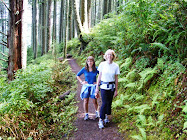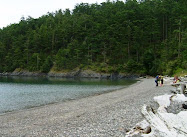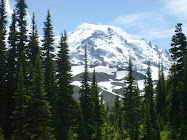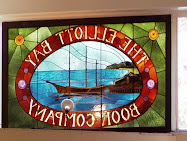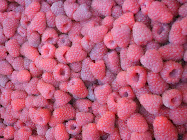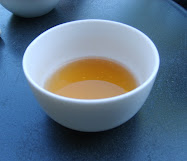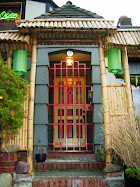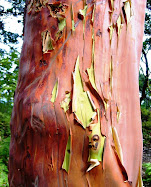
When I arrive on Lopez Island, I make a beeline to Watmough Bight on the southeastern edge of the island. After parking at the end of the gravel road, I walk through the tunnel of leafy green trees to the beach.

A father and son kayak past in the tranquil bay as I walk along the beach.

Just shy of the rock wall at the other end of the beach, I hop over a few driftwood logs and cut inland on a narrow trail through the tall shrubs. Soon I’m in the forest where Chadwick Head rises steeply to my right.

About 10 minutes into my hike I stop and gaze over the natural wetland behind the beach.

After angling up the hillside along the loose trail, the forest clears into a series of rolling brown meadows interspersed with madrona and pine trees. Surely I’ll see other people up here on this sunny afternoon. But it’s just me and the ravens and dragonflies.
Remember the opening scene in the Sound of Music where Julie Andrews flings her arms wide and breaks into song on an Alpine hilltop? That’s what I feel like doing up here.

I meander along the hilltop until I go as far as I can. Below the hill drops away into the forest and azure waters of Rosario Strait beyond. I settle on the ground at a comfy spot just below a rocky outcrop.
Then I just sit.

After a while I pull out the Tao te Ching and read some ancient words of Lau Tzu. This one strikes me today:
One who lives in accordance with nature
does not go against the way of things
He moves in harmony with the present moment
always knowing the truth of just what to do
I decide the truth of just what to do right now is to just breathe in the fresh clean air and exhale my pent up stress about work, money, family, life. Because this is my life at the present moment, and it’s pretty sweet.
I lean back against a rock and take in the view below. Across the strait lie several forest-covered islands—Burrows, Allen, Fidalgo, and northern Whidbey.

From the north a huge oil tanker comes cruising past not that far offshore, sinister-looking in its scale and contrast to the natural marine setting of the San Juan Islands.

Then I hear a loud slap and splash in the water a few hundred feet below and see a white circle of bubbles rise to the surface. Perhaps it’s a seal or sea lion trying to stir up some fish or just messin’ around.

Drowsy with all this pure island air and sunshine, I close my eyes and drift into a light sleep. I’m awakened by the drone of a small propeller plane, which dips its wings and heads straight in my direction, passing just a hundred feet directly above me. I think the pilot saw me.
A few hours pass and it’s time to head down to meet up with some friends. I see a makeshift swing someone has rigged onto the strong branch of a gnarled pine tree. It’s a little high, so I have to leap up onto the seat, which gets me really swinging. Now this is moving in harmony with the present moment. I highly recommend it.

When You Go
There are no signs to Watmough, but it’s not that big an island. Eventually you’ll find your way there. Click here for a map of the island showing Watmough and here for another more detailed map. Since this is a nature preserve and valuable ecosystem, be respectful of this special place and leave no trace when you leave.















